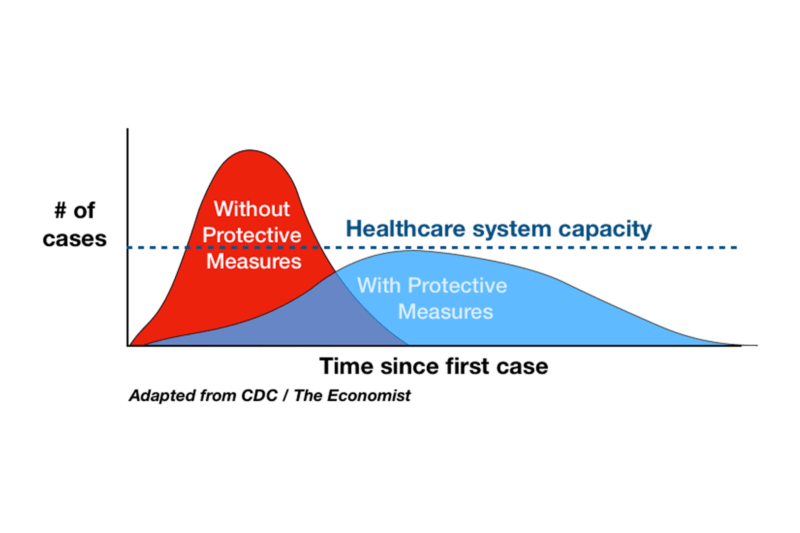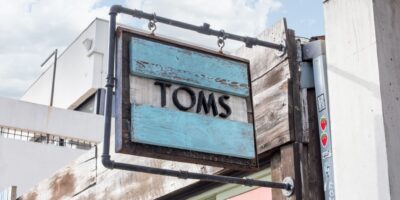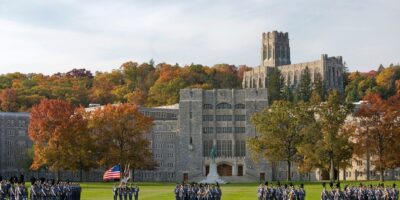The Political Economy of Mass Panic

The optimal level of risk is never zero. Otherwise, nobody would ever get up in the morning. But even staying in bed is risky (people die in their sleep). When you drive from home to work your risk of dying is nonzero. When you fly from New York to Los Angeles your risk of dying is nonzero. When you cross a traffic-heavy street your risk of dying is nonzero. When you ride a bike your risk of dying is nonzero.
Why, then, do most of us act in these types of situations as if the risk were indeed zero? The answer is because it is sufficiently low, that for practical purposes we can act as if it were zero, although we know that theoretically it’s not. After all, people die in car crashes and as pedestrians every day, they also die, although much less often in plane accidents, and some of them (hundreds) even perish from being hit by lightning every year!
Seven people in the US die of bubonic plague annually!
Yet, we don’t get scared every day of going out because we might get hit by a car, or by lightning, or fall from a bike and die from a concussion, or end up like 14th century Europeans, decimated by plague. In most everyday situations individuals are good at managing the risk level of their own behavior.
However, it is much more interesting to study what happens when the risk is unclear, when the information about relevant circumstances affecting the risk level is highly uncertain and incomplete, or at least more complicated to assess. In these situations, human society, especially when politics gets involved – and this politics is a democratic one – tends, as if almost by rule, to make horrible and self-destructive decisions, all of which create and perpetuate irrational panic and excessive risk aversion.
People act excessively scared and do many stupid and irrational things to alleviate unnecessary fear that they feel. There are multiple psychological and political mechanisms that create this dynamic that could be described as “the political economy of hysteria and panic.” It involves psychological mechanisms of availability bias, action bias, broken window illusion, as well as the widespread ethical view of pathological altruism and political dynamics of democratic shortsightedness. All these factors often conspire together in a sinister fashion to create a hysterical and irrational frame of mind towards risk, leading to wildly irrational decisions.
Let’s start with availability bias. You are probably familiar with opinion polls reporting that climate is changing faster than any time in history, and that natural disasters are getting bigger and more frequent; that we have more hurricanes, droughts, floods, earthquakes. You might be one of the people who believe this yourself. Yet, it is not true. All reports compiled by the UN Intergovernmental Panel on Climate Change (IPCC) and other scientific organizations show that most natural disasters are not getting worse, and some are getting less severe.
Why then do all too many people believe the very opposite? The answer is that the media is obsessively pushing the stories about disasters every day. In the age of satellite television and the internet there is no global disaster or catastrophe that is not immediately made visible to anyone with access to modern technology – hurricane, earthquake, forest fire – everything is immediately broadcasted and always accompanied by dramatic, often catastrophic messages of gloom and doom.
One hundred years ago a big hurricane in Florida would be in the news on page 2 or 3 of the New York Times and that would have been it. People in the directly affected region would suffer and think about it, the rest of the country and the world would just continue with their lives as if nothing had happened. Today, when a big hurricane threatens Florida, first, five days in advance meteorologists on TV are following its strengthening, changes in its path, categorizations (category 5, be scared, be very scared), all followed with the scary (satellite!) images of the eye of the storm, doing their best to scare the daylights out of everybody.
You cannot turn on the TV or even social networks without being bombarded with the fear mongering about the hurricane. Governors and local mayors would be evacuating everybody for days before the hurricane strikes to the delight of the media, further fueling the panic. There would be little else the media would talk about for a week. When the storm finally hits Chris Cuomo of CNN would stand in the rain to demonstrate how tough he is and also how frightening the storm is. The same applies in different degrees to every other disaster in every other country: it becomes major news instantly and stays such for a long time.
It should not shock you then that most people would think that disasters like hurricanes are much more prevalent than they are and that they are getting worse. It’s a known cognitive illusion everyone is susceptible to, to consider things directly visible and observable to be more prevalent and in a sense more real than those you see less often.
Psychologists tested this in many different settings. Very early in the 1960s Kahneman and Tversky conducted a famous experiment where they asked a group of participants whether in the English language there are more words that begin with the letter “K” or those where the letter K is the third letter. Most interviewees answered the former (at the beginning of the word) whereas in reality there are three times more words in English language with the letter K as the third letter.
The reason why people have chosen the first and false option was simply that it’s much easier to recall the words beginning with the letter K than those where the same letter is in the middle of the word! That’s availability bias. That’s the same reason why people in 2020 believe that there are much more natural disasters than people in the 1920s thought; not because there are really more (there are not) but because they daily and even hourly see much more news about them than people in the 1920s did.
This becomes a serious problem when the activity or phenomenon subject to availability bias is significantly associated with risk. If the availability bias is the reason that people believe that some very bad outcome is far more likely than it really is, then the same people will act excessively risk-averse in response to the perceived danger.
The recent Covid-19 epidemic in the USA is a tragic cautionary tale. The respiratory disease, for everything we know, is similar to a severe, pandemic flu. The symptoms are similar, and the death rate according to the initial estimate of the Centers for Disease Control is between 0.16% and 0.33% (later estimates don’t provide a unique IFR, but a range of different IFR for different age groups show an extremely strong age gradient after 70 and an exceedingly low death rate for those younger than 40). A comprehensive review of all antibody studies done so far by world-renowned epidemiologist John Ioannidis found that the average death rate of Covid-19 is about 0.27%, with some regional variations.
This is certainly higher than the seasonal flu, but very close to a severe pandemic flu, like the one the world experienced in 1957 and 1968 (without doing anything to “tackle” them). Indeed Dr. Anthony Fauci himself, the President’s principal scientific adviser for epidemics, in co-authorship with Dr. Robert Redfield, director of the Centers for Disease Control, published a paper in the New England Journal of Medicine on March 26th of 2020, saying: “If one assumes that the number of asymptomatic or minimally symptomatic cases is several times as high as the number of reported cases the case fatality rate may be considerably less than 1. This suggests that the overall clinical consequences of COVID-19 may ultimately be more akin to those of a severe seasonal influenza (which has a case fatality rate of approximately 0.1%) or a pandemic influenza (similar to those in 1957 and 1968) rather than a disease similar to Spanish flu, SARS or MERS, which have had case fatality rates of 9% to 10% and 36%, respectively.”
An overwhelming majority of people who died of Covid were older than 70 and already had other significant ailments like heart disease, diabetes or obesity. Among children and young people the disease is much less severe than seasonal flu. Additionally, children are far less likely to transmit the virus than older people, which is in stark contrast to the flu, where children are the main spreaders and sufferers.
All of these facts were known for a long time and are not disputed seriously by most experts. Yet, they’ve had almost zero influence on how people reacted to the disease and what politicians did in response to it. Schools and colleges were promptly closed in March 2020, almost all businesses were ordered to shut down and most of the population was forced to lock themselves up at home for months, pushing the country into the deepest economic depression since the 1920s!
The same Dr. Anthony Fauci, who wrote on March 26th that the Covid death rate was likely “similar to severe seasonal influenza or pandemic influenza” the very next day said on television that “The mortality of [Covid-19] is about 10 times that of the flu”. Obviously, the reasons for this were not “scientific:” whatever the cause of this dramatic change in assessment might be, we have some doubts that Dr Fauci studied the problem so thoroughly in the night between March 26th and March 27th and discovered that Covid-19 was not similar to the flu, but ten times worse. We think it’s far more likely he did this for political or other, nonscientific, reasons, while ignoring science.
The reason everything was shut down was mass psychosis and hysteria, fueled by media “reporting,” creating a powerful political pressure to “do something.” Media drumbeat of fear and panic, in a typical “if it bleeds it leads” fashion, using anomalous cases of young people dying or becoming severely ill, exaggerated or highly speculative projections based on models and not on the empirical data, and experts like Fauci and Redfield cooperating in lending their scientific credentials to the propaganda machine, even when their scientific findings did not justify alarmism.
This helped spread panic among the population, by breathlessly pushing and promoting the outlandish forecasts by some irresponsible “experts” about millions of people who will die and so on.
This constant drumbeat of apocalyptic fear mongering “convinced” (or rather scared) the majority of people that the end is indeed nigh, that everybody will die and soon and nobody is safe. As a predictable consequence, people started acting increasingly irrationally. The infamous scenes of toilet paper and hand sanitizer disappearing from the shelves are the most dramatic illustration of what happened, shortages of ordinary merchandise that developed in many parts of the country was another.
The great psychologist Carl Gustav Jung noticed long ago that these collective psychic epidemics can have much more frightening effects than real disasters: “It is becoming ever more obvious that it is not famine, not earthquakes, not microbes, not cancer, but man himself who is the greatest danger to man, for the simple reason that there is no adequate protection against psychic epidemics, which are infinitely more devastating than the worst of natural catastrophes.”
Hence, availability bias is the major reason why people tend to severely overestimate the level of risk they are facing. If they are bombarded with the news about different real instances of disease and death they will certainly start believing that these instances are much more widespread than they really are. Yet, what they are going to do about it is predominantly determined by a different bias they suffer from, the so-called action bias.
We evolved over millions of years in conditions of constant physical danger from wild animals, storms, floods, etc., or from hostile groups of human hunter-gatherers. The peaceful human society in which people are not daily worried for their lives is, from an evolutionary point of view, a very recent phenomenon, brought about by the agricultural revolution in the Bronze Age.
In our evolutionary dominant lizard brain the concept of danger and risk is still associated with the concepts of fighting or running away from the enemy, with doing something dramatic to overcome or arrest the danger. The “flight or fight” bodily reaction that entered the modern lexicon with the increase in the incidence of anxiety disorders is a biological expression of this. We are “hard wired” to do stuff in order to achieve results.
When we are in danger, or perceive ourselves to be, the human heart increases its rate, dramatically bringing more oxygen to the muscles and allowing us to run faster and longer and fight harder against animal or human enemies. For us moderns who don’t need this mechanism so much, a particularly sinister maladaptation has developed.
Here the flight-or-fight physical mechanism is triggered even in the absence of any actual danger. We might be sitting in a library, or on a beach; there is no tiger or a hostile tribesman attacking us, but we still feel as if we are under severe threat all the same. That’s called an anxiety or panic attack when people are sweating, their heart is beating fast and they are in mortal fear of dying but there is nothing wrong with them physically and there is no outside danger either. We desperately want to run away but there is nobody chasing us.
We are fine as we are, but are incapable of recognizing that and admitting it to ourselves. It’s a maladaptive relic of a vital biological mechanism our barbaric ancestors in the African jungles or Eurasian steppes needed to survive.
This is just the most dramatic example of action bias. Even in nonclinical settings people react in similar maladaptive ways. Whenever there is a social crisis, or a (perceived) social problem of any kind, or a natural disaster, we always want to “do something,” because in our lizard brain we equally see the source of our troubles in some hostile action by some identifiable malign agent or agents against whom or which we must react, and soon.
Yet, the grave problem is that social and economic problems are seldom caused by some evil agent doing something sinister: most often they are a product of some systemic and complex causal chain where many things at the same time are happening and nobody controls the result. And consequently, and more importantly, there is nothing that anybody, including politicians, can do to make things better (but they can make them worse!).
Hence, sometimes the best and most rational way of encountering social or economic problems or other sources of modern anxieties is just to sit back and do nothing! As Buddhists do in their insight meditation. Sit down and calmly observe how stupid you are! But the caveman in us, dominated by his primitive lizard brain, cannot accept doing nothing as a solution for any problem. He is all too often already in the fight-or-flight mode, convinced that the tiger is around the corner and about to eat him for dinner, so he has to run away somewhere somehow!
If a recession is approaching the media will start pumping stories about human suffering that outrage or scare the public and politicians have to engage in fiscal policy (debt-financed spending) to show they are doing something: climate change panic, please do something, carbon tax, ban this or mandate that; epidemic, lock up everybody, order them to wear masks, or space suits, or anything. Do something!
What then happens is a classical instance of a positive feedback loop. The media scares the population with endless “reporting” about the upcoming carnage of this or that sort, people panic and demand that politicians do something about that and protect them. Politicians, concerned about their own popularity start doing something – usually the most ineffective and meaningless but expensive and theatrically appealing thing, to avoid looking “weak” and “indecisive.”
The media then uses these “protective measures” as “proof” of how serious the situation is, feeding even more frenzy and fear, leading to even more panic and more citizens’ demands that politicians do something. Think of a small snowball, rolling down a hill, gathering more mass as it goes.
The main factor driving this dynamic is the nature of the implicit “social contract” existing in most modern democracies: citizens obey, and the government protects them against risks of any and all kinds. Smoking, climate change, high prices, low prices, recessions, diseases, natural disasters, racism, corporate greed, Chinese competition – it does not matter what, the government has a duty to outlaw all of it, or face white-hot anger for its “failure of leadership.”
If anything bad happens – it’s the government’s fault. Of course, the government in most cases cannot protect anyone against any of these problems (all too often, however, it can make them worse), but that’s not the point – the point is that it has to pretend it can, and it must make reassuring gestures to that effect. It is just like the parents who promise to frightened children who wake up at night with nightmares that they are going to kill the monster that is threatening them. So, when a crisis of any kind appears, the government has to gesture in a similar vein vigorously that it is doing something meaningful and is “in control.”
Don’t worry citizens, your government is vigorously chasing, (at your expense, but they don’t mention that) the monsters and mirages attacking you from all sides. One of the great dangers for democracy and the rule of law does not stem so much from dictators and autocrats wanting to obliterate them, but rather from the people themselves who want protection from everything by the government.
If people expect politicians to eliminate or greatly reduce the level of risk and uncertainty in their lives (as they invariably do) then they relinquish an awful lot of power to politicians. Trifles like the US Constitution and the Bill of Rights, tying the hands of government, are great obstacles to this new democratic “social contract.”
Modern politicians have to behave as autocrats even if they are deep down not, because all too many voters want them to. “Public servants” who refrain from such abuse of power are considered weak and even cruel by the very electorate on which they depend. A politician who believes in strict limitations of political power does not stand much chance to be kept in office given a hysterical, infantilized citizenry that wants protection from cradle to grave against all dangers, real and imagined. If subjects want to be enslaved and hence protected by you, and if the only way for you to be their ruler is their approval of you, then you have to behave as their slave-master. There is no real choice.
This is why so many governors, both Republican and Democrat, trashed all the protections offered by the US Constitution, shut down the whole society for months, prohibited people from working, walking, from going to the beaches, parks, schools, restaurants, all in the name of protecting them against the virus. It was not because they particularly enjoy playing petty tin-pot dictators (although some do), but because they don’t enjoy being blamed for the “failure of leadership.”
If you as an elected official do something idiotic and ineffective but nevertheless dramatic and theatrical you are protecting yourself against criticism much better than if you follow logic and evidence and refuse the diktat of mad crowds. The politician, not unnaturally, thinks along the following lines: If I do nothing, bad things will happen and everybody will blame me for doing nothing, because if I had done something bad things would not have happened. If I do something really radical and dramatic, no matter how ineffective, bad things will happen again, but then I can say: “See, I did everything I could and bad things happened anyway, which means if I had not done it, it would have been even worse.”
That’s why governors did not hesitate for a second to close the schools in March, 2020 although it was already known that children are virtually invulnerable and spread the disease far less than adults. That’s why governors ordered hospitals to stop most other medical procedures and concentrate only on Covid, although it was plain that this would lead to excess deaths from other diseases, such as heart disease and stroke, that may dwarf in the long run Covid deaths.
That’s why governor Cuomo of New York prohibited people from walking alone in the parks and beaches, that’s why Michigan governor Whitmer prohibited people from visiting their own vacation homes alone! It’s reducing criticism that they don’t care or “failed to lead.” In the technical language of political science that’s called “covering your ass” (CYA). Politicians in a democracy, most of them, don’t want dictatorial powers. They just want to get elected and reelected. But to get reelected you need to prove that you care and “do something,” which often means to use dictatorial powers to impose insane policies that the majority wants.
There is another powerful cognitive illusion that enables this kind of behavior, allowing politicians to take credit and shift blame and avoid accountability and that is the famous “broken window” illusion. The story was first told by a French economist from the 19th century Frederic Bastiat in his essay “That Which is Seen and That Which is Not Seen.” In this story a young boy breaks a window of a bakery and runs away. And although most people would think of this as an act of vandalism and destruction, some socialist economists argue that this destruction is actually beneficial.
Think about it; the window is broken, the baker has to hire glaziers and workers to replace his property. A couple of new jobs or at least new gigs will be created that otherwise would not have existed. The young vandal is improving the economic welfare of society. Yet, that is not at all the case: for every new increase in economic activity and exchange created by destruction there is more that is lost. The only difference is that the lost activity is not observable; it is “unseen.” Emphasize directly observable benefits to isolated groups, ignore delayed and not yet observable costs for the majority.
In the case of lockdowns the broken window fallacy applies to both economic and noneconomic costs and benefits. The main mantra of the early days of the epidemic was “flatten the curve.” That meant we had to apply so-called “social distancing” (not being around other people) not to stop the virus, or reduce deaths but to protect the health care system by slowing down the spread and allowing hospitals to gradually manage the patient inflow without overwhelming stress on beds and ICU capacity.
Graph 1 shows the difference between the “do nothing” option and “social distancing.” The former would lead to a fast and dramatic spike in hospitalizations overpowering the health care system, whereas the latter would distribute cases more evenly over time, allowing the system to stay afloat. The idea behind this is that the number of deaths will be reduced, not directly, but indirectly, by relieving the health care system.

Yet, the drastic measures of lockdowns and social distancing which are extremely costly will have to be maintained for much longer. That means that economic activity, including the health care system will suffer much more and much longer. And direct economic and noneconomic costs will be much higher than without lockdowns. But they are not immediately visible and covered by the media.
The panic created around coronavirus reduced dramatically the number of hospitalizations for very serious conditions like strokes, heart attacks or cancer. Many people who would have gone to see a doctor were too afraid of getting the virus and died at home. Some preliminary estimates in England say that it is likely that at least 35,000 cancer patients would die as a consequence of the diversion of health care resources from treating regular patients (like cancer screenings, tests and procedures) to preparing for the Covid surge that never happened.
Experts who predicted this surge and convinced politicians to essentially shut down the health care system for months for most other patients will be responsible for tens of thousands of preventable deaths. In America the number of people who sought doctors’ help for stroke and heart attack fell during the lockdown by 30%-50%. Many of these people were, because of the relentless media hysteria, too afraid to go and see a doctor. Some of them died, some of them got much worse and will be much more difficult to treat.
Yet, all of these deaths and sufferings will be spread over a longer period of time and will not be shown on television. CNN will not be quick to run the stories about the carnage that their own hysterical “reporting” helped create. These people will die quietly and lonely, without anyone to plead their case in the public, and to avenge them by asking for accountability of those who were responsible for their deaths – politicians, media and “experts.” In the arena of public policy, unfortunately, information asymmetry between direct benefits and indirect costs, protects the wrongdoers from accountability for the damage they inflict.
Conclusion
The situations of collective insanity characterized by mass hysteria and panic are almost impossible to handle reasonably in a democratic society. A positive feedback loop between media “reporting” on disasters, real or imagined, the sense of dread, panic and urge to do something by the public and the response of the politicians to satisfy this collective demand for ritual action make calm and rational handling of the situation all but impossible.
The demand for action creates the pressure to avoid being perceived as weak and indecisive on the part of politicians, while the information asymmetry between the visible, concentrated and identifiable benefits of “action” and delayed, speculative and more distributed costs of action, makes irrational and ineffective but ritualistic policies much more likely. Policies adopted to deal with the Covid-19 pandemic illustrate very painfully these truths.










